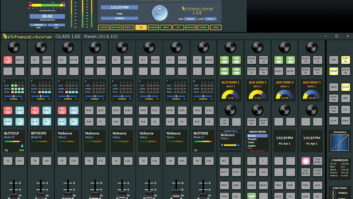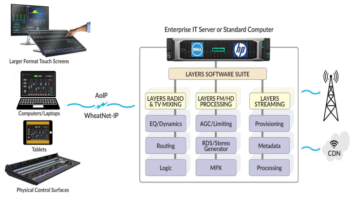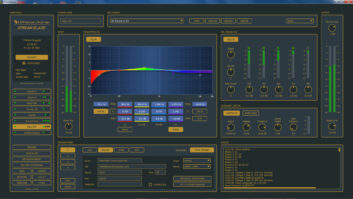SAN DIEGO — About six months ago I took over as the chief engineer of legendary jazz station KSDS/88.3 in San Diego. KSDS was licensed in 1951 and is the definition of a heritage station. KSDS made the switch to jazz in 1973. Jazz stations in today’s homogenized corporate-controlled environment are a true rarity. KSDS is San Diego’s radio jewel.

The station had just built brand-new studios, outfitted with four new Wheatstone LX-24 consoles, and had just deployed an ENCO automation system. KSDS had never been automated prior to the new studios. The transmitter site was a well-built facility with a pair of Harris Z FM transmitters, but the antenna …
Well, the antenna is a five-bay, vertical-only antenna on a 200-foot flag pole. Yes, a 200-foot flag pole.
PROTECTION
The 22 kW signal was set up as vertical-only to protect XETV Channel 6, which has since signed off. For those who have never been to San Diego: It has some mountainous terrain combined with some deep valleys. Add that to a vertical-only antenna, and the term multipath takes on new meaning.
The old processor was still in place (the only thing not replaced during the remodel). I tried various things to minimalize the multipath, but nothing that the old processor could do would help. That processor, now 12 years old, locks up on a regular basis, turns the audio into a garbled mess and just simply isn’t loud. It needed to be replaced. After all, this is Market No. 17, and one of the last full-time jazz stations in the country deserves the best!
I started looking at my options. I was convinced after a visit by Kelly Parker of Wheatstone that I needed to take a look at the AirAura X3. I contacted Wheatstone’s Jay Tyler and Darrin Paley, who sent me a demo unit. It happened to be the same time that another manufacturer sent me their top-of-the-line processor.
There was almost no tuning of the X3, I put on a preset, and let it run. It sounded great and loud out of the box. It took a while to set up the competitor’s processor, as it showed up with no presets. Once I had them both set up almost identically, I drove to L.A. one weekend while listening to the AirAura X3. I noticed that I had listened crystal-clear to KSDS past Oceanside (where I always lost the station), and for the first time I was able to pick up KSDS even past Oceanside! I called General Manager Ken Poston and he said that for the first time, he listened in his car crystal clear on his driveway in Escondido, San Diego’s extreme north east county.
WHEATSTONE EXPLAINS ITS MULTIPATH MITIGATION SOFTWARE
Wheatstone’s Mike Erickson explains:
The multipath mitigation software is located in the back end of the processing just before the composite domain. It monitors the overall L–R signal before it heads to the stereo generator. Based on the user settings, it can tactfully reduce stereo separation on cuts that have excessive L–R information. This provides a more predictable signal to the receiver and helps mitigate aggressive blending.
This smart algorithm is available in all Wheatstone processors currently on the market. Another aid to reception issues (especially in extreme competitive situations) is a composite processor that allows users to switch between clipping and look ahead limiting. If users are in a region that has multipath issues and up against high-octane audio, switching from composite clipping to the look ahead limiter option can help reduce the choppy, clippy audio that is a hallmark of processors that only rely on composite clipping.
I called Wheatstone, and they confirmed that they had some software that they had written for the X3 that practically destroys multipath. I should say so.
After a week with the X3 on the air, I switched to the competitor’s processor and drove the same route to L.A. As predicated from past drives, at Oceanside our audio was completely gone. The GM called me and told me that he couldn’t pick up the station well in his driveway either. The weird thing is that to achieve the same loudness as I had with the X3, I had to drive the competitor’s box harder, and compress more.
The amazing thing is that the Wheatstone AirAura X3 was $1,000 cheaper, and fixed KSDS’ multipath issues.
KSDS sounds great, has a great signal and it is all because of the AirAura X3. I have never in my many years in broadcasting been so impressed with a processor. With a price of around $12,000 fully loaded with all the HD options, and the amazing multipath fighting software, this is a bargain.
The amazing thing is that at Wheatstone they have in the audio lab one of every model of audio processor ever made. They listen to the old and new when building these boxes, but unlike other companies they are feeding them into exciters, and listening on tuners as listeners would. I am hypercritical when it comes to broadcast gear. I love the overbuilt RCA gear, and that’s what I expect from any broadcasting gear.
The Air Aura X3 is the best processor on the market for any size market. If you have multipath, try the X3. If you want loud and clean, try the X3. The X3 will make a remarkable difference in your station. I don’t normally preach about a product; but after the drastic change it made for KSDS, I was astonished.
For information, contact Jay Tyler at Wheatstone in North Carolina at
(252) 638-7000 or visit www.wheatstone.com.












